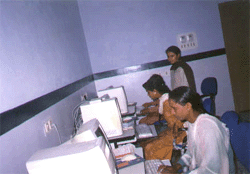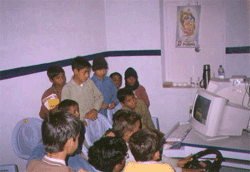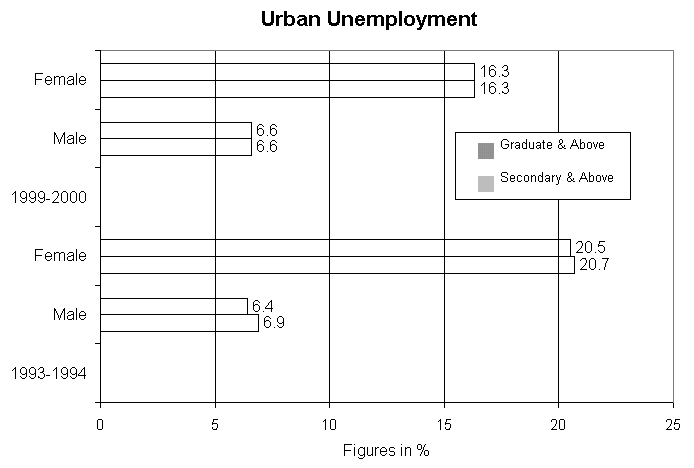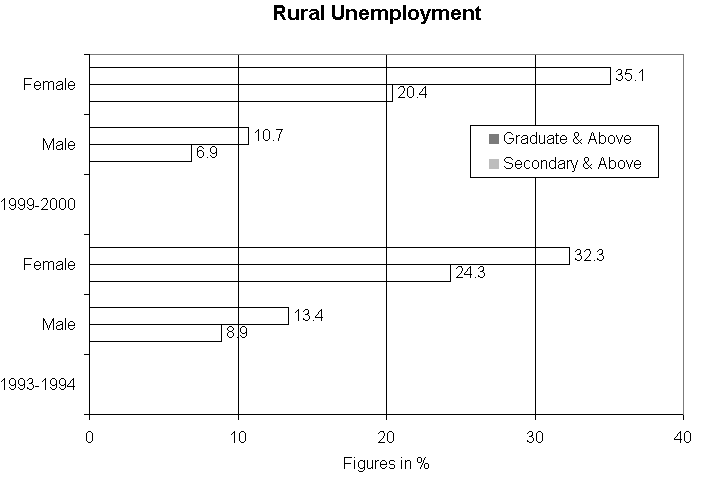| TARAgyan:
Empowerment through Education
|
L
et’s face it: the
Indian farmer has
never had it so good. Despite socio-economic disparities and absence of
infrastructure, thirteen good monsoons have created a flood of economic well
being. There is ready cash in many a rural pocket.
Earlier, in the eighties, due to a set of chance factors as
well as by policy design, traditional perceptions that literacy was unnecessary
almost vanished. The much-touted ills of our education system notwithstanding,
and despite the ‘missing girl-child’ syndrome, today parents all over the
country are increasingly ensuring that their children go through some schooling.
The poor see basic education and literacy as the key to unlocking the fetters
of poverty and lack of choice. For the better off, education is widely seen as a
major way of improving prospects, productivity and profits. Combine this widely
felt demand for education with the (relatively)
vibrant economic situation, and one has a
recipe for creating a nation of learners. Even if we now get a few disastrous monsoons, it is likely that the vacation from productive
employment so created will be spent in retraining, extending one’s learning,
and preparing for better days.

|
On the positive side, this is potentially one of the most hopeful
developmental signals from the Indian rural society in recent decades. On the
negative side, it is easy to unscrupulously exploit this demand. Low literacy levels of the older
generation allow large numbers of learners to be duped by teaching shops
providing mass scale doses of sub-standard information - this is lucrative; it
is happening. So, when TARAhaat began operations, it did not require a market
survey to recognise that amongst all information-oriented services, education
was the one most in demand: by an order of magnitude more than others. At least
for now and for some more time to come.
|
| Broadening
New Horizons ..... |
Therefore, TARAgyan (Hindi, gyan = ‘knowledge’,
used here in the sense of ‘education’) was started on a priority basis as
TARAhaat’s education channel, aiming to deliver meaningful, world-class
education, right in the learners’ village, and in their own language.
What kind of gyan does TARAgyan give?
A major route for creating sustainable livelihoods in large numbers is
through education. TARAhaat sees
education as a prerequisite to creating sustainable livelihoods
by providing job skills (avenues to money, enhancement of skills on the job) and
life skills (enrichment of life, health and productive use of leisure). A second
order prerequisite is meaningful conventional education (an avenue to diplomas
and degrees), so as to create motivation and ability to utilise the other types
of learning ultimately required for a livelihood.
TARAgyan operationalised this thinking by defining three
streams to begin with: vocational education, self-improvement courses, and
conventional education.
In keeping with the fact that a rapidly increasing number of
young people today read and write, TARAgyan does not plan to treat basic
literacy as a priority. There are a large number of philanthropic initiatives
that aim to fill this need, and it would be quite easy for these to piggyback on
TARAhaat’s increasing reach to rural illiterates. Already, the portal allows
orientation (to some degree) towards multi-media communication and ‘read out
text’ for illiterates.
The public education system has been designed for teachers to teach, not for
learners to learn. Like many systems perpetuated for the convenience of the
supplier rather than for the user, the education system has
become a teaching system, based on mindlessly memorising and
reproducing large quantities of information. Success in studies and life are
achieved despite the system, not because of it.
TARAgyan, as a lot of others, wants to break the mould, not
just for intellectual reasons but for practical ones as well. For how long can a
nation sustain a flow of schooled young people who are unemployable, except
perhaps in unproductive government jobs that are as much a part of the problem
as any other factor? The conventional ideal of a secure and salaried job is
already giving way on the ground. As a majority of Indians are literate today,
there just aren’t enough of those traditional employment avenues any more.
TARAgyan aims to arm a new generation of learners with the
tools for generating some meaning in their lives. Self-confident people,
motivated and questioning, who can grab opportunities and create their own
future. A community that might break, hopefully, the feudal chains that bind it
to an unsustainable and irrelevant way of doing things.
How does TARAgyan deliver its content?
Since everybody is different, there are immense challenges in the area of
pedagogy and technology besides social resistance to change, that TARAgyan has to grapple with. By the time TARAKendras
saturate at a number approximating 40,000, it is estimated that there shall be
over 2.75 million learners that TARAgyan shall touch each year. And, there are
no case studies to go by; there is no past experience to rely upon.
In a firmament without marked directions, three factors are
clear. One, TARAgyan’s content and delivery mechanism should use very little
local human resource. Secondly, it must use the best technologies in ICT to
create a shift of communication from one-way to two-way, from cramming to
information assimilation, indeed, towards meaningful infotainment. Three, it
must be scaleable. In the past, scaleable meant replicable, which was a
euphemism for mindlessly repeatable. Today, it is possible to conceive of
networked expert-facilitator-learner-machine systems that are customised to the
level of achievement, the aptitude, and the learning style of every individual.
TARAgyan shall rely on virtual subject area specialists,
because there is too much variety and geographical difficulty for them to be
available locally. Still, one cannot put into operation a teacher-less model
(the predominant model on the Internet today) if it has to deliver learner
confidence and values. Since TARAhaat is not just a web portal but also
essentially a network of franchised centres, TARAgyan has a way to physically
reach each student, not with specialists but with motivated ‘generalists’.
TARAgyan is developing a cadre of self-employed enabling educators to guide
student learning. There will always be the specialist and reference material at
the other end of e-mail or a chat line.
 |
But, TARAgyan’s success shall lie in
these non-virtual, human educators. Work is underway to create a large
investment in attitudinal, motivational and skills training. This training shall
be continual and ongoing, and shall become an essential TARAgyan activity.
TARAgyan shall make sure that content is offered in a multi-dimensional,
consciousness encouraging way, for example by helping learners to consider
implications of the content on social and psychological planes: by developing an inclusive
worldview and by helping learners to be aware of their own aims, choices and
methods at every step. |
Can this system cover vocational skills that may require
manipulation of objects that cannot be transmitted over a web connection that
cannot be captured in a CD? Is a significant improvement possible in, say,
masonry skills, with TARAgyan? Can coffee-tasting skills be learnt over a medium
that is primarily visual and auditory? We do not know, though best examples of
multi-media communication support coupled with video-conferencing may be a part
of the answer. By design, TARAgyan shall cross many difficult bridges when it
comes to them, at the same time setting up an enabling mechanism instead if
necessary by jumping in, dirtying its hands, experimenting, discovering what
works, adopting and adapting.
So, TARAgyan is an evolutionary and responsive process, not a
static product. Counselling and feedback, virtual or real, online or offline,
are central activities for its success.
There is a real danger of TARAgyan falling into the old
systems and becoming a tuition shop for cramming for irrelevant examinations.
This is because, even more than the mass of educators in the system, the
majority of potential learners and their parents are unaware of any other
system. They even vaguely believe that all that cramming and occasional corporal
punishment is actually necessary for learning! TARAgyan aims to turn that
orientation around. The courses under design aim to impart experience in
application, building up real skills, and recalling relevant facts from a pool
of information, and in that order of priority. This order is exactly the reverse
of that in the conventional system today.
The orientation towards application would exhibit itself by, say, starting a
word-processing course by typing a letter, learning the keystrokes, commands and
choices that appear along the way ‘on the fly’. Once the experience is
established in the student’s mind, information such as the history of word
processing may follow if the learner is interested. Since many of the
courses would aim towards employment, the needs of that employment would also
play a part in determining the learning outcomes, to the exclusion of deep
theory (which has a place in its own right, but not for TARAgyan students, at
least not for now).
Another manifestation of this learning-centered approach is how TARAgyan
monitors and grades student progress and results. Though standardised
quantitative evaluation graded by levels of difficulty is planned, the
evaluation system shall grow towards being based on individual student profiling
rather than on grades so as to capture the individuality of each learner. Every
student would get a randomised examination paper, reducing the reliance on
techniques of copying and cheating that are so common in India toady. Depending
on the subject, examinations could be framed so as to be difficult to complete
in the time allotted, forcing students not to waste time in referring and into
prioritising their attempts according to the likelihood of success in different
sections. Achievement scores and percentiles would replace the blind marking
system as commonly practiced today, while relative grading and negative scoring
may have to wait until students get used to competing with their peers. TARAgyan
believes that this approach will meet the needs of many employers who
today seek appropriate attitudes, well-written CVs, and descriptive profiles
about real skills than just certification and marks.
A central feature of TARAgyan’s content is the issue of
language. All TARAgyan communication will be without purity in language. Since
even computer systems, operated in English, are understood in the vernacular,
with technical terms and commands being retained in the original English form,
TARAgyan uses mixed language text to communicate. This feature is working well,
paralleling the use, by private Hindi television channels, of a smattering of
English terms that are common or technical.
Much of the poor quality of understanding and lack of
confidence amongst rural students can be ascribed to non-availability of
material in their own language. Sometimes, translated material is too purist
(using what used to be called ‘All India Radio Hindi’, for instance) and so
meaningless to the reader even though the target language may be her/his first
language.
In a dream world, one would get, say, the Encyclopaedia Britannica and
allow a student familiar with mainly Punjabi to hover his mouse over the text
and read it in his own language instantly. Till such time as that dream could be
realised, TARAgyan is developing a large capacity for high volume, high-speed off-line translations in all the
languages.
Another dream is to create text by speaking into the machine,
rather than by typing. Since that isn’t going to happen tomorrow, TARAhaat is
investing in easy-to-learn standardised vernacular fonts. An important decision
was made about the font maps used. This is based on the simple, observable fact
that people end up being fluent in using only one keyboard layout in their
lifetime. For better or worse, the QWERTY keyboard is a de facto
international standard. Therefore, TARAhaat does away with having to overlay
multiple language keys patches on the keyboard, or resorting to the inefficient
‘typing by mouse’ methods, or choosing between various mechanical typewriter
keyboard layouts in the Indian languages. Instead, all languages are typed in
QWERTY using Roman phonetics in Indian languages (i.e., typing "tarahaT"
leads to "tarahaT"). We find that
most users are familiar enough with the sounds and shapes of the Roman alphabet
for this technique to work even if they do not know English.
Can TARAgyan pay for itself?
Yes, it can. It is a significant revenue stream for TARAhaat
today, and will remain so in the TARAhaat network for some time to come.
TARAgyan’s commercial model is
highly flexible and shall continue to learn from field experience. At this time,
it seems that one can look at broadly three kinds of content delivery.
|
TARAgyan’s Partners
The English course is being developed by NEEV
(Network of Educational Enterprises and Ventures, a Delhi based NGO),
led by Dr. A. K. Jalaluddin and Dr. Kuldip Kumar, highly acclaimed
educationists earlier with NCERT (National Council for Educational
Research and Training). Dr. Jalaluddin, in particular, has been involved
in developing a wide variety of innovative education programmes,
including a particularly successful one in Bangladesh now covering
10,000 rural schools and to be expanded to 35,000 schools. It is based
on intensive educator training. The implementation of the Practical
English course shall iron out the difficulties in transiting from
conventional education to TARAgyan style education.
Manaswin Technologies Pvt. Ltd. is a highly
experienced Jhansi-based course developer for the Basic IT course in
Hindi.
TARAgyan’s software engine and language delivery
systems will be developed by partners. The national Open University and
open school systems have expressed interest in riding with TARAgyan, for
developing and certifying course material.
Potential collaborators include an NGO that wants to
provide better quality education in the conventional mould by providing
computers, connectivity, content, coaching, and commercial viability to
large numbers of schools. The school centre could become a special type
of TARAgyan Kendra, which would lead to its becoming commercially viable
and therefore replicable at a mass scale.
Potential employers have started meeting TARAgyan for distance
placement of TARAgyan alumni in, for example, data entry jobs delivered
both ways by e-mail, with more creative outlets for the employment
planned.
|
First,
high value skills are imparted by one-on-one learning in more or less the dominant web and CD
enabled education model today (termed type A). Second, education though a mix of
educator and machines, with an emphasis on practical hands-on task oriented
environment (termed type B). Third, a large group of students using the ICT
almost like a TV broadcast, with the additional functions of polling and
interactivity (termed type C).
With a combination of all these types, one can get about 12 registered
students per computer at any time in a TARAkendra. Centres themselves shall be
of different sizes. Small centres with one or two computers, and therefore a
limited number of students to spread overheads will be marginal. Centres with
three or more computers will generate robust revenues. In time the nationwide
average of computers per Kendra is estimated to approach five. While the cost of
courses to students will vary, the overall value to the Kendra owner is designed
to deliver Rs 40 per hour per computer, well in excess of the sustainable rate
for surfing. While TARAgyan’s share of the revenues is considerably lower than
that of the Kendra, when compounded by the total number of students is
sufficient to generate adequate returns on the substantial investment being made
in infrastructure and course developments. The nature of the mission and the
need to create a new paradigm that has not been tried in India conventionally,
TARAgyan’s investments in human resource, content and software development
will be even greater than a conventional commercial operation. . This aggregates
to millions of dollars for a number of years.
This investment itself is of two types. First, for clearly
viable and demanded courses that can pay for itself after a sufficient mass of
learners is available. Second, for socially desirable but not-so-viable courses
that can pay only for the operational delivery costs but not for the capital.
Accordingly, TARAgyan is seeking strategic partners in both the cases.
|
TARAgyan Courses
TARAgyan has two courses running in the field. One is
a (type B) course on Basic IT covering essential computing today that is
so much in demand that it needs no survey to start on it. The other is a
CD-delivered (a mix of type A and C) Paint courses targeted at younger
learners, aiming to develop creative faculties for self-improvement or
for later specialisation in graphics oriented work. This includes
contests that are delivered over the Internet. Both courses are
delivered in Hindi and Punjabi, mixed with English where required for
easier communication.
These courses are at this time being offered by five
centres each in Bathinda district (Punjab) and in Bundelkhand region (U.
P. and M. P.)
The next course in the pipeline is a Practical
English course, highly in demand. It is being developed as a task
oriented interaction using intensively trained educators who have
various resource materials at hand, but also develop and use local
resource material.
This shall be followed by vocational or enrichment
courses, as research shall indicate, such as useful courses on
agriculture, tractor repair, knitting, garment cutting, home hygiene,
childbirth, and so on.
|
So where is TARAgyan now?
There are about 400 learners who have taken some TARAgyan course or other.
Besides, about three times as
many potential learners have enquired about TARAgyan
services. While there is no conscious exclusion of the middle aged and older
persons, TARAgyan courses are currently popular with the youth. Girls are taking
these courses in a considerable number (about 25% of the total student
population). All this has happened in about three months.
TARAgyan is a lean division of TARAhaat with only two full
time professionals at this time. It believes in outsourcing as much work as
possible to partners, and not inventing everything in-house. TARAgyan has
already tied with some, while collaborations with others are continually being
explored.
A TARAgyan advisory board is also in the process of development.
Where will TARAgyan go?
TARAgyan’s internal risk factors are mainly that success
depends upon a sufficiently large enrolment. This shall be possible only in
tandem with increase in the number of TARAkendras. Its financial struggles are
mainly in finding investment and grant funds to underwrite its huge development
costs. External risks include the fact that social mobilisation may prove either
slow or expensive (in motivation and attitudinal training of a very large human
resource base). Besides all these, the pedagogical and technical factors are
major challenges in their own right.
TARAhaat promises to be one of the significant change agents
in rural Indian perceptions and attitudes, as well as a potential source of
facilitating the formation of a very large and productive, employable workforce
in the future. A pipe dream? Remember, cynics never changed the world, and parts
of this scenario are already coming true out there in the villages.
q
Sanjay Prakash
| The Stockholm Challenge |
 |
The Stockholm Challenge
is a unique Awards programme for pioneering information technology
projects that have made an impact on the lives of people and societies
on any part of the world creating new and more democratic structures.
Among the 742 projects from 90 countries in seven categories,
TARAhaat.com is one of the 14 finalists in the category – ‘A
Global Village’. |
|





